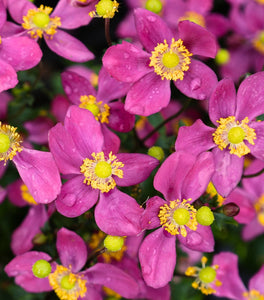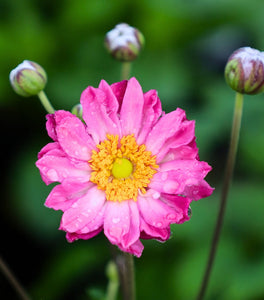
Images Depict Mature Plants
Anemone September Charm for Sale Online
Anemone 'September Charm' is an elegant and resilient perennial that adds soft, romantic hues to your late-summer and fall garden. This Japanese anemone brightens borders and mixed beds from August to October with its large, semi-double pink flowers and sunny yellow stamens. The delicate blooms stand atop tall, slender stems that sway gracefully in the breeze, making 'September Charm' a captivating focal point for cottage gardens and pollinator-friendly landscapes. This charming anemone is ideal for attracting bees and butterflies, creating a lively and colorful late-season garden.
This deer-resistant perennial thrives in partial shade to full sun and prefers well-drained, nutrient-rich soil. Anemone 'September Charm' grows up to 3 feet tall, with lush green foliage that forms a tidy clump, providing excellent ground cover throughout the growing season. Its soft pink blossoms complement other late-blooming perennials, such as asters, sedums, and ornamental grasses, offering an enchanting mix of textures and colors. Plant 'September Charm' along woodland edges, garden paths, or perennial borders to enjoy a wave of fresh blooms that transition seamlessly into autumn.
Low-maintenance and highly reliable, Anemone 'September Charm' is an ideal choice for gardeners looking to extend seasonal interest in their landscape. Once established, it requires little care beyond occasional watering during dry spells. Divide mature clumps every few years to maintain vigor and encourage abundant flowering for the best display. Whether used as a border plant, in mass plantings, or as part of a mixed bed, Anemone 'September Charm' delivers a lasting impact that will bring beauty and elegance to your garden year after year.
Anemone September Charm received the prestigious Award of Garden Merit of the Royal Horticultural Society.

| Hardiness Zone: | 4-8 |
|---|---|
| Mature Height: | 2 to 3 Feet |
| Mature Width: | 2 to 3 feet |
| Classification: | Flowering Perennial |
| Sunlight: | Full Sun to Part Shade |
| Habit: | Upright, clump forming |
| Flower Color: | Silvery-pink, dark pink undersides |
| Flowering Season: | Late Summer through Fall |
| Foliage: | Green |
| Soil Condition: | Any Average Garden Soil |
| Water Requirements: | Water well until established |
| Uses: | Extremely attractive when used in the mixed border, mass planting. Attracts pollinators and hummingbirds |
How to Care for Anemone September Charm
Before you purchase your Anemone September Charm plant, be sure to read the recommended care instructions to ensure your plant remains happy and healthy for years to come.
How do I Plant Anemone September Charm Plants?
To plant Anemone 'September Charm', start by selecting a location with partial shade to full sun, as this versatile perennial thrives in well-drained, humus-rich soil. Prepare the planting site by loosening the soil and incorporating organic matter, such as compost, to improve drainage and provide essential nutrients. Dig a hole slightly larger than the plant’s root ball, ensuring the crown is level with the soil surface. Place the plant in the hole, backfill with soil, and gently firm it down to eliminate air pockets. Water thoroughly after planting to help the roots establish well. Space multiple plants about 18-24 inches apart to give them room to spread and form attractive clumps. Anemone 'September Charm' benefits from regular watering, especially during its first growing season, to establish a strong root system. Keep the soil consistently moist but not waterlogged, as too much water can lead to root rot. Mulch around the base of the plant with a 2-3 inch layer of organic mulch, such as shredded bark or leaf mold, to retain moisture, suppress weeds, and regulate soil temperature. When planting in a mixed perennial bed or woodland edge, group Anemone 'September Charm' with other fall bloomers like asters and sedums for a vibrant late-season display. With proper care, this low-maintenance perennial will reward you with a stunning burst of pink blooms year after year.
How Do I Water my Anemone September Charm?
Watering Anemone 'September Charm' correctly is essential for its health and prolific blooming. During the first growing season, it is crucial to water regularly to help establish a robust root system. Keep the soil consistently moist but not soggy, aiming for deep watering rather than frequent shallow watering. This will encourage deep root growth and make the plant more drought-tolerant in the future. Use a soaker hose or water at the base of the plant in the morning to minimize evaporation and reduce the risk of fungal diseases affecting the foliage. Anemone 'September Charm' prefers soil that stays evenly moist, especially during the warmer summer months. Once established, Anemone 'September Charm' is somewhat drought-tolerant, but it will perform best if provided with supplemental water during extended dry periods. Aim to provide about 1 inch of water per week, adjusting depending on rainfall and soil conditions. During blooming time, consistent moisture will ensure a more abundant and longer-lasting flower display. Be careful not to let the soil dry out completely, as this can cause stress to the plant and impact its growth. Adding a layer of organic mulch around the base will help retain soil moisture, reduce evaporation, and protect the roots, ensuring your Anemone 'September Charm' thrives with vibrant blooms throughout late summer and fall.
How Do I Fertilize Anemone September Charm?
Fertilizing Anemone 'September Charm' is key to promoting healthy growth and abundant flowering. To ensure your plant thrives, start by incorporating a balanced, slow-release fertilizer into the soil at the time of planting. A general-purpose fertilizer, such as a 10-10-10 or 5-10-5 formula, will provide the essential nutrients Anemone 'September Charm' needs for both root establishment and bloom production. In early spring, as new growth begins to emerge, apply a light dose of balanced fertilizer around the base of the plant. Be careful not to over-fertilize, as too much nitrogen can lead to excessive foliage growth at the expense of flowers. For best results, fertilize Anemone 'September Charm' once more in midsummer, especially if the soil is poor or lacking organic matter. Use a well-balanced, water-soluble fertilizer, or opt for organic options like compost tea or well-rotted manure, which will enrich the soil and enhance flowering without the risk of nutrient burn. When fertilizing, make sure to water the area thoroughly after application to help nutrients reach the root zone. Additionally, adding organic mulch around the plant will not only retain soil moisture but also provide a slow-release source of nutrients as it breaks down, contributing to the ongoing health and vitality of your Anemone 'September Charm.'

How Do I Prune Anemone September Charm Plants?
Pruning Anemone 'September Charm' is an essential step in maintaining its health and encouraging a vigorous bloom display each year. Start by removing spent flowers throughout the blooming season to promote additional flowering and keep the plant looking tidy. Deadheading not only helps channel the plant’s energy towards producing more blossoms but also reduces the risk of disease by improving airflow. After the flowering season ends in late fall, trim back the stems to just above the basal foliage. Cutting back the spent flower stems will prepare Anemone 'September Charm' for dormancy over the winter months. In early spring, before new growth begins, clean up any remaining dead or damaged foliage to make way for fresh, healthy shoots. If your Anemone 'September Charm' has become overcrowded, it’s beneficial to divide the clumps every three to four years. This rejuvenation helps maintain the plant's vigor and ensures more prolific blooming. Dividing the plants also gives you the opportunity to propagate and expand your garden with new anemone clusters. By incorporating these simple pruning practices, you’ll keep your Anemone 'September Charm' thriving and ready to put on a show of beautiful pink blooms year after year.


















